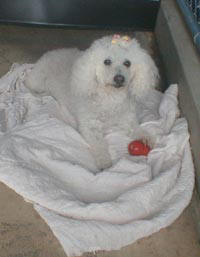|
|
Dog Perception Management by Dr.
Rolan Tripp
|
The Dog Bed
This
technique is indicated as part
of the Positive Human Leadership program,
and assumes your dog has one
or more designated "dog
beds" that he or she likes
to lay on. If the dog does not
have a favored sleeping spot
other than the human bed, this
technique is not indicated.
During this leadership program,
it is best if the dog is not
allowed on the human bed.
 In
wolf packs, the lead wolf has
access to any favored sleeping
spot as a benefit of leadership.
It is a status symbol. In the
home setting, if the dog is
disobedient, or "bossy",
the goal is to communicate that
you are the leader, and have
the right to give instructions
that are followed. One non-violent
way to indicate "in dog
language" that you have
leadership, is to sit in any
resting spot, including the
dog's bed. Conversely,
the dog can only sit in those
spots you approve. Sitting in
the dog's bed a few times,
for several seconds, is one more
way to try to communicate human
leadership, without resorting
to physical conflict. In
wolf packs, the lead wolf has
access to any favored sleeping
spot as a benefit of leadership.
It is a status symbol. In the
home setting, if the dog is
disobedient, or "bossy",
the goal is to communicate that
you are the leader, and have
the right to give instructions
that are followed. One non-violent
way to indicate "in dog
language" that you have
leadership, is to sit in any
resting spot, including the
dog's bed. Conversely,
the dog can only sit in those
spots you approve. Sitting in
the dog's bed a few times,
for several seconds, is one more
way to try to communicate human
leadership, without resorting
to physical conflict.
|
In "dog language"
if you have leadership,
you may sit in any resting
spot, including the dog's
bed.
|
 Before
doing this exercise, it is necessary
to complete other aspects of
leadership. If Before
doing this exercise, it is necessary
to complete other aspects of
leadership. If  the
dog does not see you as leader
first, and you try to take over
his or her bed, it could result in
a power struggle that might
include aggression. Other leadership
techniques are explained elsewhere,
Look for topics such as "Learn to
Earn" and others. the
dog does not see you as leader
first, and you try to take over
his or her bed, it could result in
a power struggle that might
include aggression. Other leadership
techniques are explained elsewhere,
Look for topics such as "Learn to
Earn" and others.
To
avoid any negative outcome from
taking over the dog bed, follow
these simple guidelines:
-
Test your leadership with
a surprise Instruction like SIT,
at any time, just to see if
the dog will follow your instructions.
If the dog will readily SIT
and MOVE for you, this exercise
is probably not necessary.
-
Don't trap the dog in
a bed in a corner. If necessary,
move the bed when the dog
is not present. Give an honorable
exit so you are not run over
in the process.
|
The rule is that the dog may
occupy the dog bed any time
you - as leader - don't
want it.
|
-
Pick a time when both you
and the dog are relaxed, and
the dog is in the bed.
-
Don't use your hands
to remove the dog from the
bed. Ask the dog to COME,
and reward with lavish praise
and even a cookie.
-
If the dog WILL NOT leave
the bed voluntarily, leave
a leash or long lead attached
to the collar, or use a broom
or big pillow. Do not scare,
or scold the dog for not moving.
Just be neutral, as if this
is no big deal.
-
Consider tethering the dog
to a nearby observation spot.
-
It is only necessary to sit
for a few seconds to establish
ownership of the resting spot.
-
Look at the dog, and when
the dog is acting calm, move off the bed.
-
When finished, release the
dog to go back and occupy
the bed.
-
Begin teaching the word
"off" so in the future you
can simply give a cue for
the dog to leave the bed.
Teaching Off
|
|
|